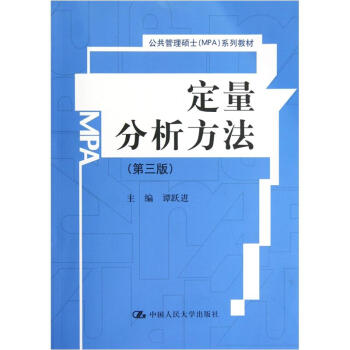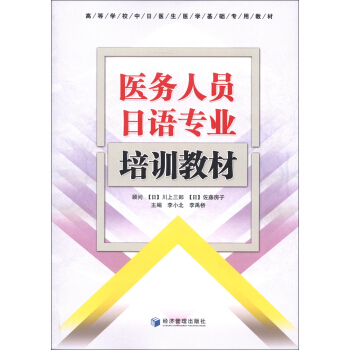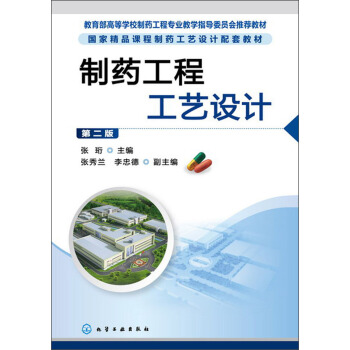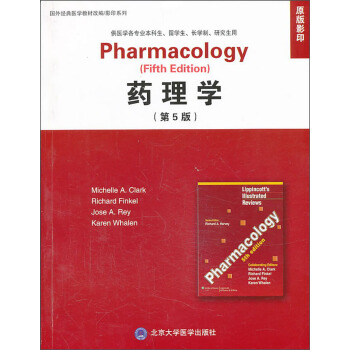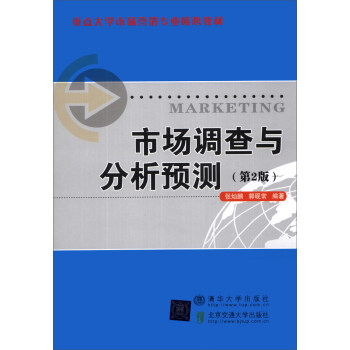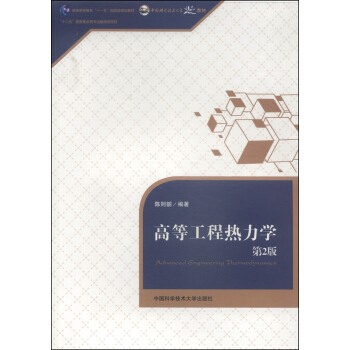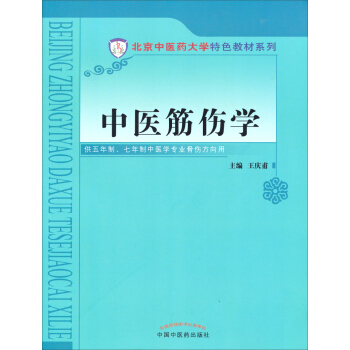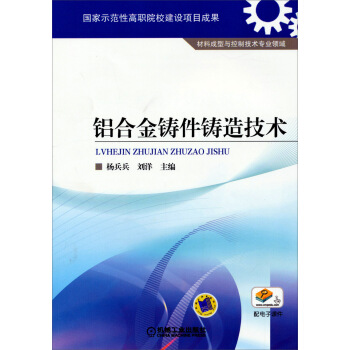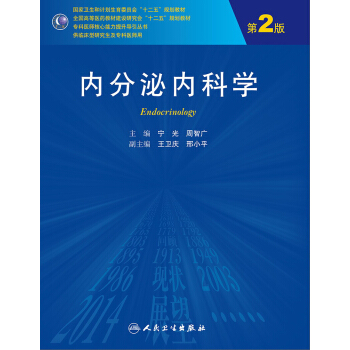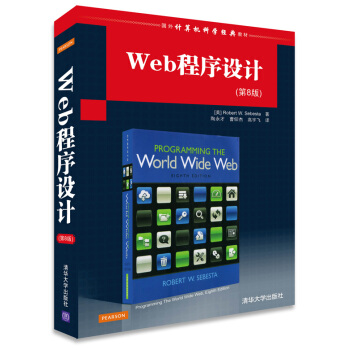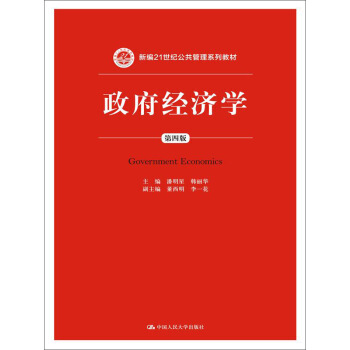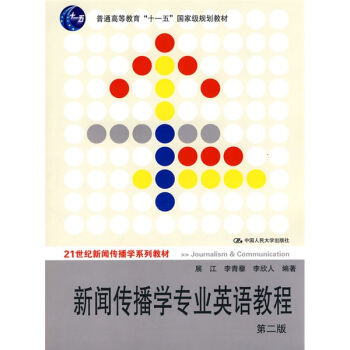

具体描述
内容简介
1.本书共分为18个单元,教学可按17~18个教学周、54学时安排。每单元由4篇选文构成(个别单元为5篇),每篇选文的长度在1000个单词左右。内容大致涵盖大众传播事业的主要部类和新闻与传播学的主要领域。2.在每单元所选文章中,根据单元主题的不同,一般有1~2篇著名学者关于该主题的经典论述,1~2篇比较具体的个案研究性质的文章,以及1篇综合性的概述(反映本学科到20世纪末的发展)。这样组合的目的,是希望能尽量做到材料新颖,容量充足,内容专业,点面结合,深浅有致,形成梯次,适合新闻与传播学专业本科生和硕士研究生共同使用。
3.本书所选文章,主要来自新闻学、传播学、政治学、经济学、法学、文化学、社会学等方面的文献。
4.课文生词的选择和释义以教育部公布的《大学英语教学大纲通用词汇表》中的四级词汇为起点,学生可参考生词表来理解课文。
5.在课后练习中,练习一采取问答题的形式,旨在培养学生理解作者的主要观点,并归纳课文主要内容的能力。
6.专业翻译能力的培养是本教材的一个重要目的。在每单元所选文章中,我们提供两篇译文,作为教学参考。
内页插图
目录
Unit 1 IntroductionPassage One The Meaning of "Communication"
Passage Two McQuails Normative Theories
Passage Three Hot and Cold
Passage Four Minervas Owi
Unit 2 Books
Passage One Books in History
Passage Two Book Publishing
Passage Three The Printing Press as an Agent of Change
Passage Four Areopagitica: A Speech for the Liberty of Unlicensed Printing
Unit 3 Magazines
Passage One Magazine as Media Innovators
Passage Two Magazines Push Images Over Words
Passage Three Luce and Time
Passage Four Early Periodical as Publicist Instrument of Criticism
Unit 4 Newspapers
Passage One What if There Were No Newspaper?
Passage Two A Newspaper Industry Casualty You May Have Missed
Passage Three The New York Times in 1990s
Passage Four Natural History of the Newspaper
Unit 5 Film
Passage One Importance of Movies
Passage Two The Structure of the Western Film
Passage Three Hollywoods Big Six
Passage Four Schindlers I.ist: The Role of Memory
Unit 6 Radio
Passage One FMs Rise
Passage Two Characteristics of American Radio
Passage Three Trends and Convergence in Radio and Sound Recording
Passage Four The Assets and Liabilities in Radio
Unit 7 TV
Passage One Impact of Television
Passage Two Culture
Passage Three The Case for Television Journalism
Passage Four CBS News
Unit 8 Internet and Media Convergence
Passage One Internet
Passage Two Worldwide Wedge: Division and Contradiction in the Global Information Infrastructure
Passage Three Weblogs, Citizen Journalists and Traditional Media
Passage Four Media Convergence and Complications
Unit 9 Media Education and Media Literacy
Passage One The Origin of Journalism Education
Passage Two What They Dont Teach at J-School
Passage Three Green-Eyeshades Versus the Chi-Squares
Passage Four Elements of Media Literacy
Unit 10 Advertising
Passage One Media Choices
Passage Two Origins of Advertising
Passage Three Advertising: The Magic System
Passage Four Advertising: Agencies and Copywriters
Unit 11 Public Relations
Passage One Defining Public Relations
Passage Two Public Relations Services
Passage Three Newsmaking
Passage Four The Roots of Public Relations
Unit 12 Media Economy
Passage One Economic Foundation of Mass Media
Passage Two The Two Economies
Passage Three Television Programming
Passage Four Rupert Murdoch
Unit 13 Culture Industry and Culture Studies
Passage One Culture Industry Reconsidered
Passage Two What Is British Cultural Studies?
Passage Three Properties of the New Media and a Socialist Strategy
Passage Four Hegemony: An Overview
Unit 14 Process of Mass Communication
Passage One Encoding/Decoding
Passage Two The Acts of Communication
Passage Three The Circuit and the Acts
Passage Four Selecting the News: Gatekeeping
Unit 15 Effects and Audience of Mass Communication
Passage One Effects Studies
Passage Two The Uses and Gratifications Model
Passage Three TV and Learning
Passage Four Scientific and Nonscientific Polls
Unit 16 Mass Communication and Society
Passage One Some Social Functions of the Mass Media
Passage Two The Masses: The Implosion of the Social in the Media
Passage Three The Debate over Civic Journalism
Passage Four Investigative Reporting
Unit 17 Mass Communication and Social Control
Passage One Government Manipulation of Media
Passage Two Of the Liberty of Thought and Discussion
Passage Three The Principles
Passage Four Jeffersons View of the Press
Unit 18 Laws and Ethics of Mass Communication
Passage One The First Amendment to the Constitution
Passage Two The Means to the End
Passage Three Should the Names of Rape Victims Be Published?
Passage Four Attributing a Libel Is No Defense
Appendix A Key to Exercises
Appendix B Chinese Translations
参考文献
精彩书摘
Two or more people come together, trying to share some information. Theyare likely to be very different people. Becausetheir life eXperienceshave beendifferent, the signs that carry the information are likely to look different to them.The more different the experiences, the more different the information that islikely to be read into them. Ideas like "pain" and "hunger" have a fairly goodchance of being understood in common because all of us have experienced thesethings——though even in this case, the "stiff upper lip" tradition of one culture islikely to be misinterpreted in a culture where feelings are more openly expressed,But words like freedom, communism, and apologize obviously are going to causetrouble when people come from different life patterns, especially if they comefrom difaerent cultures. Note carefully, however, that communication is not conducted entirely, oreven mostly, in words. A gesture, a facial expression, a pitch pattern, a level ofloudness, an emphasis, a kiss, a hand on the shoulder, a haircut or lack of one,the octagonal shape of a stop sign——all these carry information.前言/序言
本书作为国内第一部同类教材即将付梓,为它忙碌了一年有余的我们在欣慰和惶恐之际,想对编译本书的目的做一点说明。首先,本书的出版顺应了国家改革开放的大环境,同时也是对教育部大力倡导的在高校各专业开展双语教学要求的积极回应。21世纪之初,中国已成为世贸组织的成员,这标志着中国在对外开放的道路上迈出了历史性的一大步,同时也对国内的各行各业尤其是高等教育提出了新的要求。面对日益开放的社会,未来的知识型劳动大军和专业研究队伍如果不能娴熟地掌握英语这门世界通用的语言,则必将在竞争中落于人后。而英语的掌握与熟练运用,不仅意味着无障碍的日常会话与交流,对正在接受高等教育、即将成为社会中流砥柱的高校学子来说,它更意味着高层次的学术交流和专业性极强的科学研究。本书的目的,就是要引导新闻学与传播学专业的高年级本科学生和研究生直接阅读专业原著,在专业学习中巩固和提高英语水平,在英语学习中了解和研究专业知识。
用户评价
我之前接触过不少专业英语教材,但很多都显得有些枯燥乏味,要么过于偏重语言技巧,要么内容陈旧。而这本《新闻传播学专业英语教程(第2版)》却给了我耳目一新的感觉。它的编排逻辑非常清晰,从基础的词汇、短语入手,逐步过渡到句子、段落的分析,再到篇章的理解和写作训练。尤其让我印象深刻的是,它并没有简单地罗列单词,而是通过对新闻传播学语境下特定词汇的用法、含义的深入剖析,帮助我们理解这些词汇在专业语境中的细微差别,以及如何更准确、地道地运用它们。很多时候,一个看似简单的词汇,在不同的语境下会有不同的侧重,这本书正是抓住了这一点,提供了非常宝贵的指导。
评分从学习效果来看,这本书的循序渐进的设计让我感觉学习过程非常顺畅。每一章节的学习都建立在前一章的基础上,难度逐渐增加,让我在不知不觉中掌握了更多的专业知识和英语技能。即使遇到一些比较晦涩的概念,教材也会通过配以具体的英文新闻案例来解释,让抽象的理论变得更加具体和易于理解。这种“理论与实践相结合”的学习模式,大大降低了学习的门槛,也提高了学习的效率。
评分坦白说,在学习新闻传播学的过程中,我最大的瓶颈之一就是专业英语阅读能力。很多重要的研究成果、前沿理论都以英文发表,如果不能有效阅读,就等于错失了最直接的信息来源。这本教材就像一位经验丰富的向导,带领我一步步克服这个难关。它不仅仅是提供翻译,更重要的是教会我如何去理解英文新闻报道的结构、逻辑,如何抓住文章的核心观点,以及如何识别作者的意图和立场。教材中提供的分析方法和解读技巧,对于提高我的批判性阅读能力大有裨益,让我能够更深入地理解新闻背后的深层含义,而不只是停留在字面意思上。
评分总而言之,《新闻传播学专业英语教程(第2版)》是一本集学术性、实用性和前沿性于一体的优秀教材。它不仅为我打开了学习新闻传播学专业英语的大门,更重要的是,它为我提供了一个深入了解全球新闻传播领域、提升自身学术素养的绝佳平台。我非常推荐所有新闻传播专业的学生和从业者阅读这本书,相信它一定会给你带来意想不到的收获。
评分作为一本“21世纪新闻传播学系列教材”,它紧跟时代步伐,内容的时效性是我非常看重的一点。在信息爆炸的时代,新闻传播学的研究对象和理论也在不断更新迭代。这本教材的第二版,一定程度上反映了近些年来新闻传播领域的一些新变化和新趋势。我期待它能涵盖一些关于社交媒体、大数据、人工智能在新闻传播中的应用等内容,这对我理解当前新闻业的转型至关重要。当然,即使只是对现有理论和实践的深入挖掘,也足以让我受益匪浅。
评分这本教材还有一个非常值得称赞的地方,就是它在语言风格上的严谨性和学术性。它所选取的例句和段落,都展现了专业新闻传播学英语的典型特点,即精准、客观、逻辑性强。通过模仿和学习这些范例,我不仅学会了如何使用正确的专业术语,更重要的是培养了一种严谨的学术思维方式。这种思维方式对于我今后的学习和研究,是无价的财富。它不仅仅是语言的学习,更是对一种专业素养的塑造。
评分这本《新闻传播学专业英语教程(第2版)》的出现,对于我这个新闻传播专业的学生来说,简直是及时雨。翻开第一页,就被它厚重的学术气息和精炼的排版所吸引。作为“十一五”国家级规划教材,它在内容深度和广度上都有着毋庸置疑的保障。我尤其看重它“专业英语”的定位,这意味着它不仅仅是简单的词汇和语法讲解,更是将新闻传播学的核心概念、理论框架以及前沿发展,都融入到英语的学习语境中。在阅读过程中,我发现教材精心挑选了大量来自国内外权威新闻媒体、学术期刊的原文案例,这些案例的选择既有代表性,又紧扣学科脉络,让我能够在学习英语的同时,潜移默化地吸收新闻传播学的知识,这是一种非常高效的学习方式。
评分我非常喜欢教材中为每一章设计的练习题。它们形式多样,包括词汇辨析、句子改写、段落翻译、摘要写作、甚至还有针对特定新闻事件的评论练习。这些练习不仅巩固了课堂上学到的知识,更重要的是,它鼓励我去主动思考和运用所学内容。特别是写作部分的训练,让我有机会将理论知识与实践相结合,尝试用专业、地道的英语来表达自己的观点,这对于我未来的学术写作和论文撰写,无疑是极大的帮助。每一次完成练习,都感觉自己离专业更近了一步。
评分在我看来,这本《新闻传播学专业英语教程(第2版)》的价值绝不仅限于“学英语”这个层面。它更像是一扇窗户,让我得以窥见世界新闻传播领域的前沿动态和学术争鸣。教材所引用的素材,涵盖了从传统媒体的报道模式到新媒体的传播策略,从宏观的媒介政策分析到微观的受众心理研究,几乎触及了新闻传播学的所有重要分支。通过这些英文材料的学习,我不仅提升了英语水平,更重要的是拓宽了我的学术视野,让我能够站在更高的平台上去审视国内的新闻传播现象,思考未来的发展方向。
评分我想强调的是,这本书不仅仅是为学生准备的,对于已经从事新闻传播行业,希望提升专业英语水平的从业者来说,也同样具有极高的参考价值。在工作中,我们经常需要阅读外文资料,与国外同行进行交流,一本高质量的专业英语教材,能够帮助我们更快速、更准确地把握信息,提升工作效率和专业竞争力。它的内容深度和广度,足以满足不同层次读者的需求。
评分挺好的书 送的也快 满意
评分不错不错不错不错不错
评分有难度 的,不适合自学。
评分送货速度快!正品保障
评分首先,本书的出版顺应了国家改革开放的大环境,同时也是对教育部大力倡导的在高校各专业开展双语教学要求的积极回应。21世纪之初,中国已成为世贸组织的成员,这标志着中国在对外开放的道路上迈出了历史性的一大步,同时也对国内的各行各业尤其是高等教育提出了新的要求。面对日益开放的社会,未来的知识型劳动大军和专业研究队伍如果不能娴熟地掌握英语这门世界通用的语言,则必将在竞争中落于人后。而英语的掌握与熟练运用,不仅意味着无障碍的日常会话与交流,对正在接受高等教育、即将成为社会中流砥柱的高校学子来说,它更意味着高层次的学术交流和专业性极强的科学研究。本书的目的,就是要引导新闻学与传播学专业的高年级本科学生和研究生直接阅读专业原著,在专业学习中巩固和提高英语水平,在英语学习中了解和研究专业知识。
评分东西很好,值得购买的。
评分不错的书,送货服务也不错
评分很不错,不幸的是我买错教材了。我们课堂要用的是另外一本……谁要买吗,我便宜卖了哈哈
评分挺好的书 送的也快 满意
相关图书
本站所有内容均为互联网搜索引擎提供的公开搜索信息,本站不存储任何数据与内容,任何内容与数据均与本站无关,如有需要请联系相关搜索引擎包括但不限于百度,google,bing,sogou 等
© 2025 book.tinynews.org All Rights Reserved. 静思书屋 版权所有

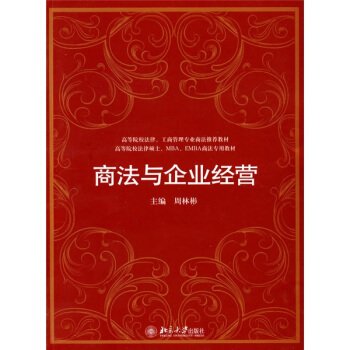
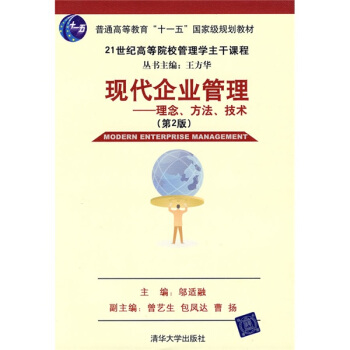

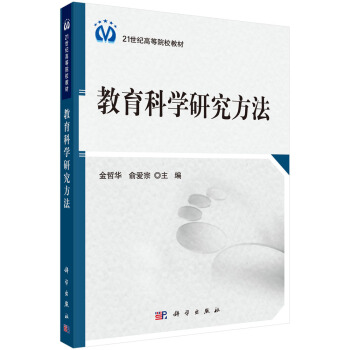

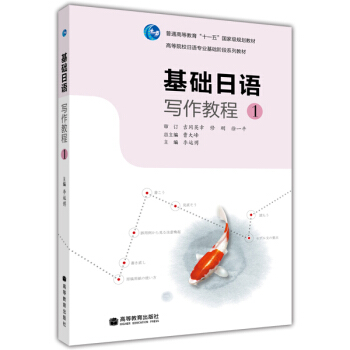
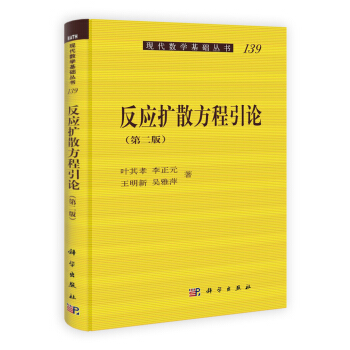
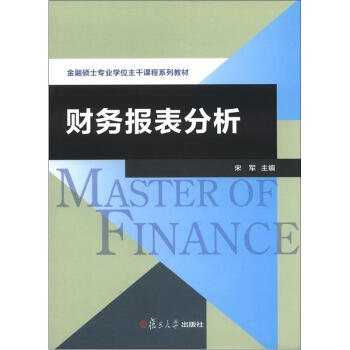
![消费经济学(第2版)/普通高等教育“十一五”国家级规划教材 [Consumption Economics(Second Edition)] pdf epub mobi 电子书 下载](https://pic.tinynews.org/11110267/rBEHaFCI2X4IAAAAAADIxJUogWMAACemAAugO0AAMjc335.jpg)
